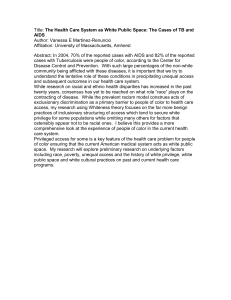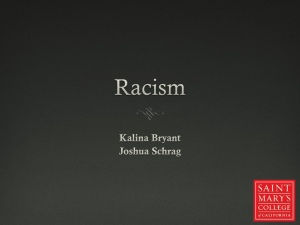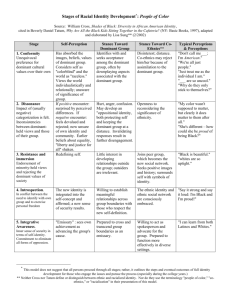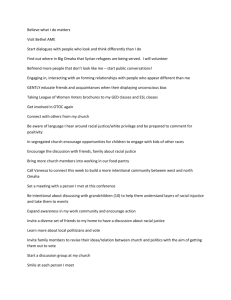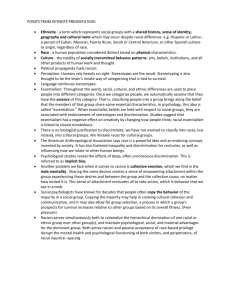White Privilege and Cultural Racism
advertisement
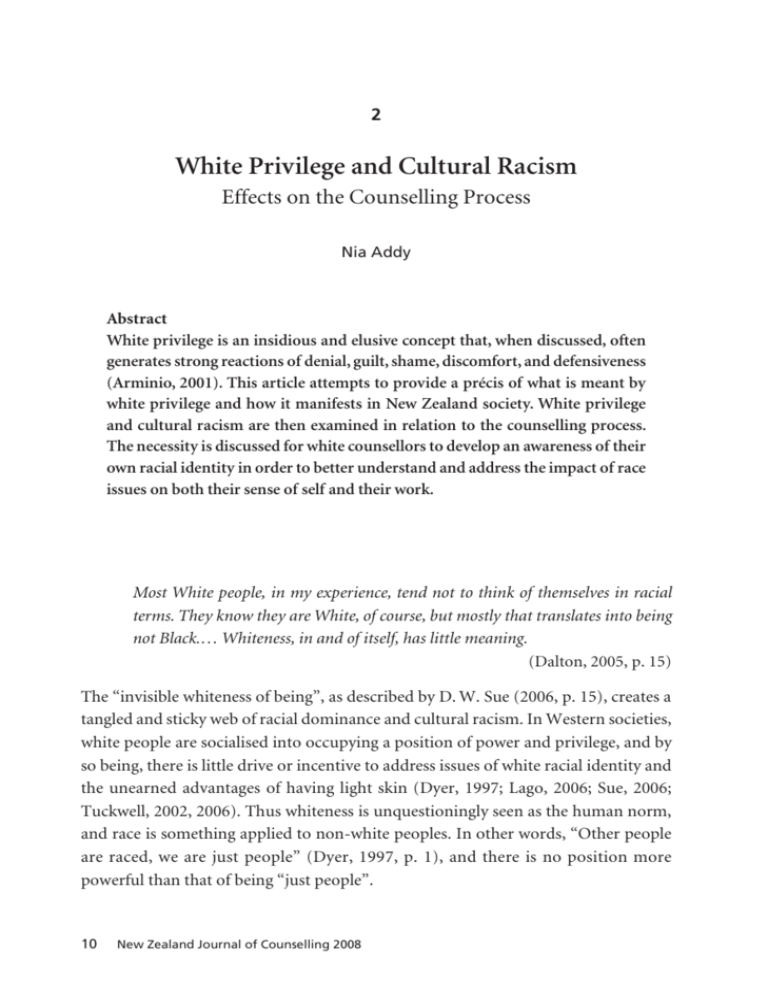
2 White Privilege and Cultural Racism Effects on the Counselling Process Nia Addy Abstract White privilege is an insidious and elusive concept that, when discussed, often generates strong reactions of denial, guilt, shame, discomfort, and defensiveness (Arminio, 2001). This article attempts to provide a précis of what is meant by white privilege and how it manifests in New Zealand society. White privilege and cultural racism are then examined in relation to the counselling process. The necessity is discussed for white counsellors to develop an awareness of their own racial identity in order to better understand and address the impact of race issues on both their sense of self and their work. Most White people, in my experience, tend not to think of themselves in racial terms. They know they are White, of course, but mostly that translates into being not Black.… Whiteness, in and of itself, has little meaning. (Dalton, 2005, p. 15) The “invisible whiteness of being”, as described by D. W. Sue (2006, p. 15), creates a tangled and sticky web of racial dominance and cultural racism. In Western societies, white people are socialised into occupying a position of power and privilege, and by so being, there is little drive or incentive to address issues of white racial identity and the unearned advantages of having light skin (Dyer, 1997; Lago, 2006; Sue, 2006; Tuckwell, 2002, 2006). Thus whiteness is unquestioningly seen as the human norm, and race is something applied to non-white peoples. In other words, “Other people are raced, we are just people” (Dyer, 1997, p. 1), and there is no position more powerful than that of being “just people”. 10 New Zealand Journal of Counselling 2008 Nia Addy White privilege and cultural racism: two sides of the same coin Sue (2006) describes whiteness as the “default standard” (p. 15) by which all other groups of colour are compared, evaluated, and made visible. Racial minorities are judged using this standard and often found to be lacking, deviant, inferior, or abnormal. Whiteness is considered neutral and normative, and frequently claims to speak for the commonality of humanity. “Raced” people, on the other hand, are seen to speak only for their race, not for people in general (Dyer, 1997; McIntosh, 2002). The sense of whites as non-raced is most apparent in the absence of reference to whiteness in the habitual speech and writing of white people. For example, white people will allude to the “otherness” (the “Chineseness” or “Mäoriness”) of friends, co-workers or neighbours, and although it may be in a very friendly and inclusive manner, they would never think of speaking of the whiteness of people they know (Dyer, 1997). Thus the assumption that whiteness is the norm creates an automatic classification of “otherness” and confers a sense of racial dominance and superiority (McIntosh, 2002). This dominant position affords white people numerous unearned privileges and advantages that, for the most part, are so ingrained in white culture that they are virtually invisible to and unfelt by those who benefit from them (Akamatsu, 2002; Dyer, 2005). In her seminal work, Peggy McIntosh (2002) sought to make explicit the day-today benefits of white privilege. She described it as “an invisible package of unearned assets which I can count on cashing in every day, but about which I was ‘meant’ to remain oblivious” (McIntosh, 2002, p. 97). McIntosh compiled a list of 46 taken-forgranted ways that white privilege affects her daily life, such as: I can swear, or dress in secondhand clothes, or not answer letters, without having people attribute these choices to the bad morals, the poverty, or the illiteracy of my race. I can choose blemish cover or bandages in “flesh” color and have them more or less match my skin. I can do well in a challenging situation without being called a credit to my race. (McIntosh, 2002, p. 99) One of the most concerning aspects of white privilege is its invisibility to those who benefit from it most, and the resulting inability of white people to recognise that many of the unearned advantages they hold are a direct result of the disadvantages of other people (What Is White Privilege?, 2003). Perhaps unsurprisingly therefore, Rothenberg VOLUME 28 / 1 11 White Privilege and Cultural Racism (2005) describes white privilege as “the other side of racism” (p. 1). In fact, one internationally recognised definition of racism is the assumption that one culture has the right, power and authority to define “normality” (Consedine & Consedine, 2005). The notion that simply by being part of the dominant white culture a person is perpetuating racism, albeit unwittingly and unintentionally, can cause considerable distress and discomfort. As McIntosh (2002) discloses, “I did not see myself as racist because I was taught to recognise racism only in individual acts of meanness by members of my group, never in invisible systems conferring unsought racial dominance on my group from birth” (p. 101). In order for white people to acknowledge and address the existence of white privilege, it may be helpful to recognise such advantages as not merely “unearned” but also largely “unasked for”. The goal of making white privilege and cultural racism visible is not to elicit white feelings of guilt, but to encourage exploration and to challenge certain ways of being (Connell, 1987; Lago, 2006). Thus it is important to recognise that people are immersed within racist thinking and practices from birth, and that racism and white supremacy are one of the dominant societal discourses in Western culture (Akamatsu, 2002): If cultural racism is like the air we breathe; if it is everywhere amongst us; if it is within the social discourses and social histories that shape our very identities; then we will enact racist thoughts and practices without necessarily realising that we are doing so, or realising the effects on other people’s lives. (p. 50) Thinking about and acknowledging white privilege in a non-blaming way can create space for addressing cultural racism and inequities inherent in society. First, however, it may be useful to examine some of the more specific ways in which cultural racism and white privilege manifest in New Zealand society. White privilege in Aotearoa New Zealand Most of the authors cited in the previous section live and work in the US or UK, and their discussions are based on the particularities of their societies and populations. Although many parallels can be drawn between these countries and New Zealand in terms of societal norms and values, infrastructure, etc., it is important to examine the specific ways in which white privilege and cultural racism reside here in Aotearoa New Zealand. It could be argued that in New Zealand, the wide adoption of the Mäori term 12 New Zealand Journal of Counselling 2008 Nia Addy Päkehä to represent New Zealanders of European descent could serve to “make visible” the invisibility of the whiteness and “race” of white New Zealanders in a way that is uncommon in mainstream US or UK society. However, one does not need to scratch too deeply to reveal inequities and oppression present in Aotearoa. New Zealand faces the issues of a society that has seen an indigenous group alienated from its resources and traditions (Spoonley, 1993, p. 108). As Consedine and Consedine (2005) expound: In New Zealand white privilege evolved in colonial times where structures were put in place that were designed to meet the needs of Pakeha settlers. Immigration, assimilation, and integration policies directly benefited Pakeha and marginalised Maori, yet these systemic structural benefits remain “invisible” to most Pakeha. (p. 200) Throughout New Zealand’s colonial history, all basic infrastructures operated on the assumption that being Päkehä was “normal”. As such, there was only one law and language that mattered, only one way to make decisions, and one way to organise education, healthcare and justice systems: the “white way” (Consedine & Consedine, 2005). Mäori were required to fit into Päkehä culture and systems. They were expected to learn the Päkehä way of life; Päkehä certainly did not expect to learn the Mäori way of life (Consedine & Consedine, 2005, p. 209). Tikanga (Mäori custom) was considered irrelevant and extraneous if Mäori were to assimilate and succeed. The only aspects of Mäori culture that were encouraged were those deemed beneficial to the country, such as sport or tourism (Consedine & Consedine, 2005). Thus, the colonial climate fostered the notion of Mäori, not only as “other”, but also as “inferior” and “less than” everything European, a notion that some authors maintain is still deeply embedded in the unconscious of Päkehä today (Consedine & Consedine, 2005). As part of a feminist team teaching a university course which examined experiences of Mäori, Pacific and Päkehä women, Alison Jones (2001) discovered that although Päkehä students had enrolled in the course specifically to examine cultural issues, they “expressed a bitter and active resistance to their Maori and Pacific Islands teachers’ expressions of their cultural identities and interests” (p. 281). Excerpts from the Päkehä students’ journals included the following: The introduction to the lecture was in Maori, which even though it was obviously appropriate, was disappointing as I could not understand it … I was brought up to believe that speaking a language your guests or audience could not understand VOLUME 28 / 1 13 White Privilege and Cultural Racism was rude, and as I do not know of any Maori who do not speak English, this seemed unnecessary. This is I know a cultural difference, but my reaction was that perhaps I should just leave the class now and let everyone else get on with it. (Maree, cited in Jones, 2001, p. 279) It felt to me like [the Tongan lecturer] was talking to the Maori and Pacific Island students and the rest of us were just there to listen … I know our cultures are different, but I found this really disrespectful for the rest of the class and it made me feel personally that I wasn’t part of the lecture (Karen, cited in Jones, 2001, p. 281) These responses may encapsulate the taken-for-granted assumption that the “Päkehä way” is the right way of doing things, although they may also reflect more complex psychological responses to the dynamics in these teaching and learning contexts. Even those with an expressed desire to learn about “other” cultures were bewildered, angry, and defensive when teaching occurred in a manner that did not privilege their ways of knowing. The Päkehä students wanted to learn about cultural difference, but on their own terms (Jones, 2001). Bell (2007) proposes that the students in Jones’ study signify “our absolute comfort with occupying the centre, with our own ‘normality’ and with occupying a position of power … which we don’t even see is one of power”. Bell argues that this attitude is not an individual failing but is, instead, a result of our socialisation and history as descendants of a colonising and dominant culture. Both Jones (2001) and Bell (2007) also draw attention to the Western-orientated belief that people have an automatic entitlement to knowledge, that they should be able to know anything and everything, including Mäori cultural knowledge. This assumption presumes that, via intellectual absorption, Päkehä should be able to, in some way, incorporate Mäori cultural knowledge into their own worldview. But, Bell argues, “Mäori don’t want that. Mäori know what assimilation is like and what it does and how problematic it is to be enveloped in Päkehä understanding.” Furthermore, the concept that access to knowledge should be freely available to all who seek it is incongruent with the Mäori belief that, in recognition of its power, some knowledge should be for limited distribution only (Consedine & Consedine, 2005). Dyer (1997) points out that some of the sharpest criticism has been aimed at those who would see themselves as least racist. He comments that some white liberals become amazingly angry when attention is drawn to their whiteness, when they are seen by non-white people as white. Dyer suggests that this is because the examination 14 New Zealand Journal of Counselling 2008 Nia Addy or highlighting of difference challenges the liberal belief in a universal subjectivity (“we are all just people”) that they think should make racism disappear. This attitude is frequently referred to as the “colour-blind” perspective (Gushue & Constantine, 2007; Neville, Worthington, & Spanierman, 2001; Richardson & Molinaro, 1996). Colourblind attitudes reflect the seemingly benign position that race should not and does not matter; it maintains that all people have equal access to economic and social success, regardless of race (Frankenberg, 1993). For example, a study conducted by the New Zealand Human Rights Commission in 1980 concluded, “I believe that by far the majority of Maoris consider themselves as New Zealanders and are quite happy to live as the rest of us [do]” (Blackburn, 1980, p. 6). This attitude portrays a deep emotional investment in the myth of sameness, while simultaneously reflecting the dominance and implied superiority of whiteness and the “white way”. There is clearly a need for Päkehä/white people to develop a critical consciousness regarding the ways in which they benefit from white privilege and their role in perpetuating racism (Ancis & Szymanski, 2001). White privilege and the counselling relationship … in all cases, the counselor, client and counseling process are influenced by the state of race relations in the larger society. (Sue, Arredondo, & McDavis, 1992, p. 479) Several authors have discussed the fact that unexamined white privilege, ethnocentrism and unintentional racism can profoundly obstruct counsellors’ ability to develop multicultural counselling competencies (Ancis & Szymanski, 2001; Lago, 2006; Sue et al., 1992; Tuckwell, 2002, 2006). Tuckwell (2006) suggests that white counsellors rarely consider the impact of whiteness on their interactions in the counselling room. This is particularly concerning when considering the position of power that counsellors occupy in the counselling relationship (Egan, 2002). Add to that the inherent power conferred through membership of a dominant cultural group (white, in this instance) and the potential for power inequity between counsellor and client is increased manyfold (Lago, 2006). Sue (2005, 2006) alludes to the difficulty white people face in acknowledging that they have biases and prejudices, and that they have engaged in racial oppression (albeit unknowingly). He suggests such a realisation contradicts their self-image and identity as good and moral persons. However, Sue stipulates that if white people are to become VOLUME 28 / 1 15 White Privilege and Cultural Racism allies in the battle against the perpetuation of racism, then white privilege is a reality they must confront. If they are unwilling to explore their own Whiteness and racism, if they continue to deny that they have prejudices, and if they continue to allow the status quo to be undisturbed, they knowingly or unknowingly have entered into a conspiracy of silence that protects the conditioned meaning of Whiteness. (Sue, 2006, p. 22) New Zealander Charles Waldegrave (1998) points out that, although unintentional, the predominance with which Päkehä values and norms dictate the organisation of societal structures simply continues the process of colonisation. He implores “therapists and teachers” (p. 412) to recognise the significance of their influence and understand that they have a huge responsibility in this area. Being aware of the social context is not enough; in order for white counsellors to avoid the inadvertent replication of existing societal attitudes and power imbalances, they need to develop a specific understanding of white racial identity and attain increased self-awareness from a racial perspective (Tuckwell, 2006). The journey into white awareness begins with recognition of the implications of the silence around being white, and with an initial step from denial to ownership of “whiteness”. This is not always easy, as the collective white denial of privilege inhibits the process of questioning, discussion, and reflection (Kincheloe, Steinberg, Rodriguez, & Chennault, 1998; Lago, 2006). However, despite the discomfort of doing so, the acknowledgement of their part in the history of racial domination, as well as the continuance of ongoing cultural racism and white privilege, is an essential stage in Päkehä relinquishing the unspoken power of whiteness (Ancis & Szymanski, 2001; Tuckwell, 2006). Tuckwell also notes that because white people have generally been socialised to disregard their whiteness, white counsellors’ sense of their own racial identity has frequently been absent as a component of the counselling relationship. This may result in white counsellors avoiding uncomfortable feelings and insecurities by either ignoring racial issues entirely or over-focusing on clients’ racial or cultural material. White racial identity awareness models The 1980s and 90s saw the emergence of cognitive developmental models of white racial identity. Theorists such as Helms (1984, 1990, 1995), Ponterotto (1988) and Sabnani, Ponterotto, and Borodovsky (1991) proposed that racial identity develops 16 New Zealand Journal of Counselling 2008 Nia Addy in a linear fashion, from obliviousness or denial of racial issues through to “the abandonment of entitlement in the quest for a healthy, nonracist identity” (Leach, Behrens, & LaFleur, 2002, p. 68). Helms’ white racial identity model in particular became very popular and remains influential in the field today. Critics of Helms point out that her theory focuses on white sensitivities and attitudes to the minority “other”, as opposed to examining what it means to be white (Leach et al., 2002; Rowe, Bennett, & Atkinson, 1994). Any sense of connection to a racial group remains unexplored, meaning that “little attention is given to how whites feel about themselves” (Leach et al., 2002, p. 68). The cognitive developmental model also parallels the minority development models of the time, suggesting a similarity in development of groups who hold vastly different societal positions in terms of power and equity (Rowe et al., 1994). Finally, white racial identity models were derived from studying the relationships between white Americans and African Americans; thus the capacity for generalisation of the theory is limited, and caution is advised when translating the theories for use in a New Zealand context. Rowe et al. (1994) introduced an alternative conceptual framework that emphasised racial attitudes instead of racial identity. Their white racial consciousness theory seeks simply to describe clusters of racial attitudes held by white people, rather than ascribe larger personality constructs such as identity. However, in a comparison of the two models, Block and Carter (1996) have concluded that white racial consciousness is merely a variant of Helms’ white racial identity model. In their view, the ego statuses proposed by Helms and the attitude types put forward by Rowe and colleagues are virtually identical (Block & Carter, 1996). Irrespective of the similarities or differences, both theories provide a valuable, nuanced vocabulary for discussing the complexity of whites’ experience of race (Gushue & Constantine, 2007). While often drawing on the white racial identity and consciousness models, recent writings in the field seem to reflect a more complex and dynamic analysis of white racial awareness. An extremely useful resource to help counsellors uncover and explore their own attitudes around being white, and the privileges it affords, is An Invitation to Narrative Practitioners to Address Privilege and Dominance, developed by Raheim et al. (2006). They present a series of thought-provoking questions and exercises that guide the reader through some of the murky waters of what it means to be white. Practitioners are invited to consider the way various privileges impact upon their lives, and the importance of counsellors exploring their own history and culture is stressed. VOLUME 28 / 1 17 White Privilege and Cultural Racism The importance of white counsellors’ sense of self as a racial being: “Know Thyself” Culturally sensitive counsellors have a set of attitudes and beliefs that grow out of selfawareness, a sense of self as a cultural being, and insight into the dynamics of their own cultural realities. Lee (2006) maintains that knowledge of oneself in relation to cultural heritage can produce a strong identification with one’s people, and helps to bring a deeper feeling of belonging and meaning in life. Last year, speaking in a debate regarding white privilege, Margaret Mutu (2007), Professor of Mäori Studies at Auckland University, stated: What I would say to Päkehä is … Please be proud of who you are. Please know who you are. You have a very, very proud culture and history. Don’t come over here and reinvent one that doesn’t exist to claim that you are something you’re not. You are who you are. Michael King (1999) believed that this process had already begun in Aotearoa: “Like Maori, Pakeha people too are showing renewed interest in their cultures of origin” (p. 238). Tamasese and Waldegrave (2003) also emphasise the importance of belonging. They state that in their work with Mäori, Pacific Island and Päkehä families, it became apparent that it was just as important for Päkehä families to locate and make visible a sense of belonging as it was for their Mäori and Pacific counterparts. They encouraged Päkehä to know where you come from, who you belong to, what your history is, what your reflexes are, what are the ways that your family does things, how do they do death, how do they celebrate birth, how do they experience all these various things, and the particular impacts of historical events on their culture. (Tamasese & Waldegrave, 2003, p. 137) Päkehä and white people cannot become allies with other cultures or groups without respect for themselves and their own experiences (Spoonley, 1993). By consciously acknowledging and respecting their own culture, Päkehä/white people are more likely to value and respect other ways of knowing. Jones (1999, p. 135) invites Päkehä “to engage in the hard work of learning about their own and our own histories and social privileges in relation to ethnic others”—work that can be immensely rewarding and extremely beneficial to counselling practice. 18 New Zealand Journal of Counselling 2008 Nia Addy Implications of white counsellors’ racial awareness on the counselling process Only when white counsellors acknowledge the significance of, and become more comfortable with, their whiteness will they be able to work freely with clients who are racially different from themselves, and with racial matters (Richardson & Molinaro, 1996; Tuckwell, 2006). Gushue and Constantine (2007) propose that many white counsellors adopt colour-blind racial attitudes in an attempt to reduce the discomfort of wanting to believe in racial equality and knowing, on some level, that they benefit from the continuance of white privilege. Although a colour-blind attitude may be adopted in an effort to counter racial prejudice, the effect may be quite the opposite (American Psychological Association, 2003). The denial of racism by a counsellor has been shown to impair his or her ability to form therapeutic alliances with both white and non-white clients (Gushue & Constantine, 2007). If a client feels unable or unsafe in addressing cultural matters with a counsellor, early termination of counselling may ensue, regardless of the race of either party (Helms, 1995; Wallace & Constantine, 2005). Considerable care and attention therefore needs to occur in the therapy room in order for issues of race and culture to be named and addressed (Prowell, 1999). A counsellor who is aware of both the racial context and the impact of race on her or his own identity will have a better chance of developing therapeutic alliances in which clients feels their experiences are validated (Gushue & Constantine, 2007). Research using Helms’ (1995) white racial identity model found that less advanced racial identity statuses were generally related to lower levels of multicultural awareness, knowledge and skills, whereas more advanced statuses were positively related to multicultural counselling competency (Vinson & Neimeyer, 2003). In fact, there is some evidence to suggest that more advanced racial identity development is not only related to higher levels of multicultural counselling competence, but also to higher levels of overall counselling competence (Gushue & Constantine, 2007. Most commentators do not expect all white counsellors to be at the highest levels of white racial awareness. Rather, they beseech counsellors to reflect thoroughly on their own whiteness and to recognise that unexplored racial attitudes may be detrimental to the counselling alliance and process (Gushue & Constantine, 2007; Helms, 1995; Lago, 2006; Richardson & Molinaro, 1996; Tuckwell, 2006). As Tuckwell (2006, p. 211) declares: Only as we engage at a visceral level with uncomfortable and emotionally charged issues will we be free enough to articulate racial matters meaningfully with our clients and work at depth with racial dynamics in the counselling process. VOLUME 28 / 1 19 White Privilege and Cultural Racism Exploring one’s own racial consciousness can be a complex and challenging journey, and is one that may be best shared. Lago (2006) stresses the need for supervisors to examine issues of racial consciousness with their supervisees, and Raheim et al. (2006) strongly recommend exploring these issues with colleagues or friends. Try “googling” white privilege: there are some interesting discussions in cyberspace. For example, a blog by Ampersand (2005) entitled How Not to Be Insane When Accused of Racism (A Guide for White People) contains some basic but very worthwhile advice. Conclusion Over the past two decades, the emphasis in multicultural counselling has been on looking at issues of “difference” or “diversity” (Richardson & Molinaro, 1996). Although our desire to know and understand as helping professionals is driven by our desire to be equipped to best assist our clients, Päkehä/white counsellors need to explore the position from which they are looking. As members of a profession for whom awareness and thoughtful reflection are paramount, Päkehä/white counsellors need to embrace a broader understanding of themselves that is embedded in, and determined by, a wider society (Lago, 2006). Whiteness remains invisible to many white people, but it is very visible to people of colour (Consedine & Consedine, 2005; Sue, 2006). If we are to challenge the perpetuation of unearned white privilege and cultural racism, white people must work. By viewing ourselves as “raced” rather than the “default standard”, we can engage in open discussion about what it means to be white, including the privilege it affords. White people need to take responsibility for defining whiteness in a non-defensive and non-racist manner, and take anti-racist action at individual, institutional, and cultural levels (Sue, 2001, 2006). The discussion of white privilege can induce feelings of guilt, hopelessness, and a sense of individual deficit, but it is important to remember that this, like many other types of privilege, is conferred by birth rather than through any individual action or belief. Creating safe spaces that allow for open exploration and meaningful discussion may be a useful way of examining our awareness of the ways in which white privilege impacts upon the lives of both ourselves and our clients. 20 New Zealand Journal of Counselling 2008 Nia Addy References Akamatsu, N. (2002). Cultural racism: The air we breathe. The International Journal of Narrative Therapy and Community Work, 4, 48–51. American Psychological Association. (2003). Guidelines on multicultural education, training, research, practice, and organizational change for psychologists. American Psychologist, 58, 377–402. Ampersand. (2005). How not to be insane when accused of racism (A guide for white people). Retrieved March 22, 2008, from http://www.amptoons.com/blog/archives/2005/12/02 /how-not-to-be-insane-when-accused-of-racism/ Ancis, J. R., & Szymanski, D. M. (2001). Awareness of white privilege among white counseling trainees. The Counseling Psychologist, 29(4), 548–569. Arminio, J. (2001). Exploring the nature of race-related guilt. Journal of Multicultural Counseling and Development, 29, 239–252. Bell, A. (2007). “Sweet As?”: Ethnic and Päkehä NZers talk identity and dominance in a colonised land. Retrieved September 13, 2007, from http://sweetasconference.blogspot.com/2007/05 /becoming-pkeh-dominance-and-its-costs.html Blackburn, A. W. (1980). Racial harmony in New Zealand: A statement of issues. Wellington: Human Rights Commission, Race Relations Office. Block, C. J., & Carter, R. T. (1996). White racial identity attitude theories: A rose by any other name is still a rose. The Counseling Psychologist, 24, 326–334. Connell, S. (1987). Beyond guilt. Wellington: Radio New Zealand. Consedine, R., & Consedine, J. (2005). Healing our history: The challenge of The Treaty of Waitangi (updated ed.). Auckland: Penguin Books. Dalton, H. (2005). Failing to see. In P. S. Rothenberg (Ed.), White privilege: Essential readings on the other side of racism (2nd ed., pp. 15–18). New York: Worth Publishers. Dyer, R. (1997). White. London: Routledge. Dyer, R. (2005). The matter of whiteness. In P. S. Rothenberg (Ed.), White privilege: Essential readings on the other side of racism (2nd ed., pp. 9–14). New York: Worth Publishers. Egan, G. (2002). The skilled helper: A problem-management and opportunity-development approach to helping (7th ed.). Belmont, CA: Brooks/Cole. Frankenberg, R. (1993). White women, race matters: The social construction of Whiteness. Minneapolis: University of Minnesota Press. Gushue, G. V., & Constantine, M. G. (2007). Color-blind racial attitudes and white racial identity attitudes in psychology trainees. Professional Psychology: Research and Practice, 38(3), 321–328. Helms, J. (1984). Toward a theoretical explanation of the effects of race on counseling: A Black and White model. The Counseling Psychologist, 12, 153–165. Helms, J. E. (1990). Toward a model of White racial identity development. In J. E. Helms (Ed.), Black and White racial identity: Theory, research, and practice (pp. 49–65). Westport, CT: Greenwood Press. VOLUME 28 / 1 21 White Privilege and Cultural Racism Helms, J. E. (1995). An update of Helms’ White and people of color racial identity models. In J. G. Ponterotto, J. M. Casas, L. A. Suzuki, & C. M. Alexander (Eds.), Handbook of multicultural counseling (pp. 181–198). Thousand Oaks: Sage. Jones, A. (1999). The limits of cross-cultural dialogue: Pedagogy, desire and absolution in the classroom. Educational Theory, 49(3), 299–316. Jones, A. (2001). Cross-cultural pedagogy and the passion for ignorance. Feminism & Psychology, 11(3), 279–292. Kincheloe, J. L., Steinberg, S. R., Rodriguez, N. M., & Chennault, R. E. (1998). White reign: Deploying Whiteness in America. New York: St. Martin’s Press. King, M. (1999). Being Pakeha now: Reflections and recollections of a White native. Auckland: Penguin Books. Lago, C. (2006). Race, culture and counselling: The ongoing challenge (2nd ed.). Berkshire: Open University Press. Leach, M. M., Behrens, J. T., & LaFleur, N. K. (2002). White racial identity and white racial consciousness: Similarities, differences, and recommendations. Journal of Multicultural Counseling and Development, 30, 66–80. Lee, C. C. (2006). Updating the models of identity development In C. Lago (Ed.), Race, culture and counselling: The ongoing challenge (2nd ed., pp. 177–186). Berkshire: Open University Press. McIntosh, P. (2002). White privilege: Unpacking the invisible knapsack. In P. S. Rothenberg (Ed.), White privilege (pp. 97–101). New York: Worth Publishers. Mutu, M. (2007, August). Native affairs. Auckland: Mäori Television Neville, H. A., Worthington, R. L., & Spanierman, L. B. (2001). Race, power, and multicultural counseling psychology: Understanding white privilege and color-blind racial attitudes. In J. G. Ponterotto, J. M. Casas, L. A. Suzuki, & C. M. Alexander (Eds.), Handbook of multicultural counseling (2nd ed., pp. 257–288). Thousand Oaks: Sage. Ponterotto, J. G. (1988). Racial consciousness development among White counselor trainees: A stage model. Journal of Multicultural Counseling and Development, 16, 146–156. Prowell, J. (1999). Reflecting on issues of culture. Gecko, 2, 43–50. Raheim, S., Carey, M., Waldegrave, C., Tamasese, K., Tuhaka, F., Fox, H., et al. (2006). An invitation to narrative practitioners to address privilege and dominance. Retrieved August 1, 2007, from http://www.dulwichcenter.com/privilege.htm. Richardson, T. Q., & Molinaro, K. L. (1996). White counselor self-awareness: A prerequisite for developing multicultural competence. Journal of Counseling and Development, 74, 238–242. Rothenberg, P. S. (2005). Introduction. In P. S. Rothenberg (Ed.), White privilege: Essential readings on the other side of racism (2nd ed., pp. 1–5). New York: Worth Publishers. Rowe, W., Bennett, S. K., & Atkinson, D. R. (1994). White racial identity models: A critique and alternative proposal. The Counseling Psychologist, 22, 129–146. 22 New Zealand Journal of Counselling 2008 Nia Addy Sabnani, H. B., Ponterotto, J. G., & Borodovsky, L. G. (1991). White racial identity development and cross-cultural training: A stage model. The Counseling Psychologist, 19, 76–102. Spoonley, P. (1993). Racism and ethnicity (2nd ed.). Auckland: Oxford University Press. Sue, D. W. (2001). Surviving monoculturalism and racism: A personal and professional journey. In J. G. Ponterotto, J. M. Casas, L. A. Suzuki, & C. M. Alexander (Eds.), Handbook of multicultural counseling (2nd ed., pp. 45–54). Thousand Oaks: Sage. Sue, D. W. (2005). Racism and the conspiracy of silence. The Counseling Psychologist, 33, 100–114. Sue, D. W. (2006). The invisible whiteness of being: Whiteness, white supremacy, white privilege, and racism. In M. G. Constantine & D. W. Sue (Eds.), Addressing racism: Facilitating cultural competence in mental health and educational settings (pp. 15–30). Hoboken: Wiley. Sue, D. W., Arredondo, P., & McDavis, R. J. (1992). Multicultural counseling competencies: A call to the profession. Journal of Counseling and Development, 70, 477–486. Tamasese, K., & Waldegrave, C. (2003). Family therapy and the question of power. In C. Waldegrave, K. Tamasese, F. Tuhaka, & W. Campbell (Eds.), Just Therapy—A journey: A collection of papers from the Just Therapy team New Zealand (pp. 131–145). Adelaide: Dulwich Centre Publications. Tuckwell, G. (2002). Racial identity, White counsellors and therapists. Buckingham: Open University Press. Tuckwell, G. (2006). Specific issues for white counsellors. In C. Lago (Ed.), Race, culture and counselling: The ongoing challenge (2nd ed., pp. 204–216). Berkshire: Open University Press. Vinson, T. S., & Neimeyer, G. J. (2003). The relationship between racial identity development and multicultural counseling competency: A second look. Journal of Multicultural Counseling and Development, 31(4), 262–277. Waldegrave, C. (1998). The challenges of culture to psychology and postmodern thinking. In M. McGoldrick (Ed.), Re-visioning family therapy: Race, culture, and gender in clinical practice (pp. 404–413). New York: The Guilford Press. Wallace, B. C., & Constantine, M. G. (2005). Africentric cultural values, psychological helpseeking attitudes, and self-concealment in African American college students. Journal of Black Psychology, 31, 369–385. What is White Privilege? (2003). Retrieved August 7, 2007, from http://www.mtholyoke.edu /org/wsar/intro.htm VOLUME 28 / 1 23

